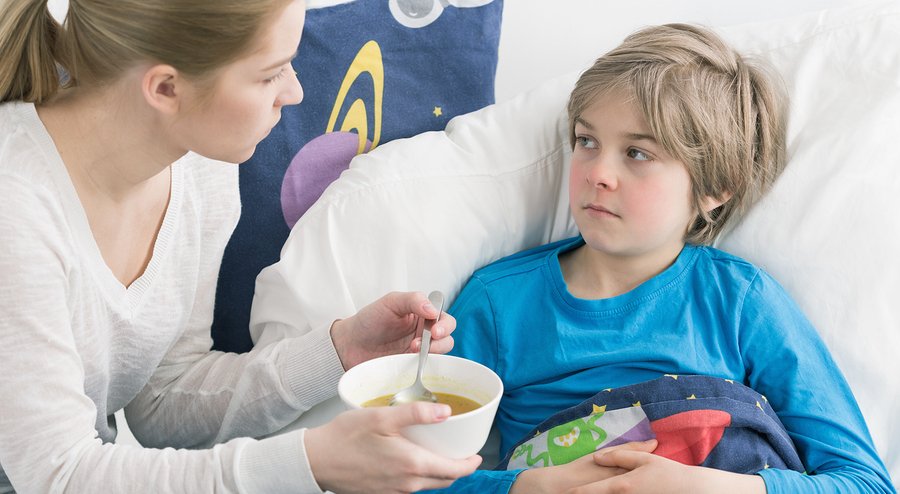If you learned the adage “feed a cold, starve a fever” as you were growing up, you’re hardly alone. But is there actually any merit to this old wives’ tale? Well, as it turns out, Mom really does know best…sort of. New research suggests that we should take it seriously as it might help us fight off infections more effectively.
The study, which was conducted at the Yale School of Medicine in New Haven, Connecticut, found that when we feed a viral induced cold and starve a bacteria induced fever we may bolster our immune system’s capacity under both scenarios to fend off the pathogens making us sick.1 Wang, Andrew; et al. “Opposing Effects of Fasting Metabolism on Tissue Tolerance in Bacterial and Viral Inflammation.” Cell. 8 September 2016. Accessed 12 September 2016. http://www.cell.com/cell/fulltext/S0092-8674(16)30972-2. Mice were the subjects of this investigation, which was comprised of several related experiments after the mice were infected with various germs.
For the initial experiment, a group of mice received Listeria monocytogenes, a bacterium associated with food poisoning. Needless to say, the mice lost interest in food and stopped eating. Those that were allowed to skip meals recovered. But some of the mice were force fed, and a portion of this group died. Interestingly, it wasn’t all food that lead to fatalities. When fed proteins and fats, the mice didn’t die; only the mice fed glucose did. The scientists also dispensed a glucose molecule called 2-DG, which prevents the body from metabolizing glucose, to some of the mice being force fed, and those mice survived the infection.
A second group of mice was infected with a flu virus known as A/WSN/33. The outcome in these virally infected mice was the opposite of that in the bacterially infected mice. Those mice force fed with glucose recuperated, while the ones fed no glucose or provided with 2-DG ended up dying.
In an attempt to determine why there were such different results depending on whether the infection was viral or bacterial, the researchers performed brain scans on the mice that had died during the experiments. The scans revealed that the portion of the brain affected varied depending on which type of pathogen caused the infection. This may suggest that our metabolic system plays a role in influencing the signals sent out by the brain to impact the immune system.
As the trials took place in controlled laboratory conditions, no other factors were involved that might have played a role in the strengthening or weakening of the germs. Therefore, it would appear to make a compelling case for the presence or absence of glucose as the single key to whether each mouse would survive their infection—again, depending on whether the infection was viral or bacterial.
While these results are thought provoking, we do need to remember that the experiments were on mice, not people. Our metabolism, immune system, and other bodily functions do not operate the same way. That much is readily apparent just from the outcomes alone—most of us are not going to perish as the mice did if we do feed a fever or starve a cold. But when we forgo food (or at least sugar) during a bacterial infection or make sure we eat something nutritious while fighting a viral infection, we just might help bolster our immune defenses and shorten the duration of the illness.
These findings are in line with those of earlier research as well. In fact, a 2002 study at the Academic Medical Center in Amsterdam, The Netherlands also found merit in starving a fever and feeding a cold in human subjects through balancing the activation of T cells in the immune system.2 van den Brink, Gijs R.; et al. “Feed a Cold, Starve a Fever?” Clinical and Diagnostic Laboratory Immunology. January 2002. Accessed 13 September 2016. www.ncbi.nlm.nih.gov/pmc/articles/PMC119893/.
But there are other opportunities to shore up your immunity and fight off infections too. Take the Baseline of Health approach to naturally optimize your immune system and prevent yourself from developing infections much of the time. And when you do get sick, use an anti-pathogen formula with natural, high-quality ingredients that strengthens your defenses so your body can get rid of the germs—bacterial or viral—and return to a healthy state quickly.
References
| ↑1 | Wang, Andrew; et al. “Opposing Effects of Fasting Metabolism on Tissue Tolerance in Bacterial and Viral Inflammation.” Cell. 8 September 2016. Accessed 12 September 2016. http://www.cell.com/cell/fulltext/S0092-8674(16)30972-2. |
|---|---|
| ↑2 | van den Brink, Gijs R.; et al. “Feed a Cold, Starve a Fever?” Clinical and Diagnostic Laboratory Immunology. January 2002. Accessed 13 September 2016. www.ncbi.nlm.nih.gov/pmc/articles/PMC119893/. |












This piece is confusing… it
This piece is confusing… it seems to support the “feed a cold starve a virus” adage then ends by saying the Amsterdam study shows “merit” in “starving a cold and feeding a virus.” Which is it?
Sorry, there was a typo, it
Sorry, there was a typo, it is fixed now. It is “starve a fever, feed a cold.”
I do agree, but this fact was
I do agree, but this fact was known thousands of years ago to Ayurvedacharya (doctors) of India. The western doctors have to learn many things from the ancient Indian literature on Ayurveda.They are given nothing new to the world,I am sorry to state, the more the medicines the more the disease. In Ayurveda, in fever immediately food is discontinued, because they knew intake of food during fever aggravates the disease, and in colds, intake of plenty of water with lime juice was encouraged. In our childhood, we were never given food during fever except light liquid diet and during colds plenty of nutritious food and for the whole day, we were encouraged to sip hot water mixed with lime juice, and colds symptoms vanished in a single day.Taking of paracetamol like analgesics quickly transfers the disease into respiratory tract and unnecessary cough is triggered.
Food science of yester years
It is written in Manusmriti, “One should constantly worship food and eat it without any complaint, should feel happy and become graceful by seeing it and also be grateful to it in all ways.” Since it is food that sustains us, therefore it should be worshipped prior to consumption, Manu further states. In fact, in every religion thanks giving prayer has been clearly prescribed for everybody before one settles down to consume any food; without food even a person with robust health cannot survive more than thirty days. Even Charaka maintains that one should scrutinise food well and only eat what is wholesome, because body is the product of food. Similarly food which is pleasing in colour, flavour, taste and touch only constitute life, otherwise life is shortened. The Bhagavad-Gita also discusses in nutshell on the quality of food, which promotes longevity and health, “Foods which promote longevity, intelligence, vigour, health, happiness and cheerfulness, and which are juicy, succulent, substantial and naturally agreeable, are liked by men of Saattvika (endowed with virtue) temperament. Foods which are bitter, sour, salty, over hot, pungent, dry and burning, which cause suffering, grief and sickness, are dear to the Rajasika (impelled by passion) tendency. Food which is ill-cooked or not fully ripe, putrid, stale and polluted, and which is impure too, is dear to men with Tamasika (inert or malevolent) disposition.” (17:8-10)
Food which is agreeable to body is the fuel that maintains the inner gastric fire, because it invigorates mind. If prepared as directed, then it promotes the proper distribution of the body elements, strength, complexion and the acuity of the sense organs, whereas the contrary would lead to unwholesome effects. (Charak Samhita) Water moistens the food, salt liquefies it, alkali digests, honey synthesises, clarified butter causes unctuousness, milk promotes life, flesh gives robustness, wine causes senile degeneration, fermented grape juice stimulates digestion, liquid boiled sugar cane juice causes accumulation of morbid elements, curd causes oedema, and uncooked vegetables depress digestion. As regards preparation of food, it is mentioned in Charaka Sutras that heavy articles when cooked become light and light become heavy. For example, rice, which is heavy, when roasted becomes light, similarly heavy roasted corn flour becomes light when made into balls mixed with water. Similarly, when light oil, like olive oil, is burnt again and again while cooking, it becomes heavy. Therefore, intake of heavy food should always be in small quantity, and light in large, till one’s hunger is fully satiated. However, quantity of food has to be measured in terms of one’s power to digest. But the choice of light and heavy food applies only to the people with little strength or who are indolent, unhealthy, given to luxury and ease or of delicate health. But this rule does not apply to those whose digestive fire is inflamed due to constant physical labour. Strength, health, longevity and even one’s very life are dependent on one’s power to assimilate food that is gastric juice. Therefore, food should invariably be taken with minimal quantity of water so that it is only adequately rinsed, when one is hungry, otherwise the secretion of the gastric juice is retarded and power to digest food wanes.
In Charaka Sutras (27:349-50), it is clearly stated, “Since the life of all beings is food, therefore, the whole world runs after food. Complexion, gracefulness, good voice, long life, understanding, happiness, growth, strength and intelligence all rest upon food. Whatever is beneficial to worldly life, whatever pertains to performance of ritual practices, which may lead to heaven and whatever action leads to spiritual salvation – all these are again established in food.” Once in India, when there was a famine consecutively for twelve years and sage Vishwamitra was dying of starvation, he goes out to steal some food at night, because he knew no household was in a position to give away any alms. While searching he finds raw dog’s meat hanging in front of a house, because in those days some people had started killing their own dogs to satiate their hunger, when no other food was available. While clawing and eating the meat the owner of the house wakes up and objects, “Sir, being such an elevated soul how could you even contemplate to eat raw dog meat, because it will dislodge you from your dharma.” The reply Vishwamitra gives is worthy to be noted, “Please don’t teach me which action of mine is right, because at this moment, my dharma is to save my body. If I could save my body, only then will I be able to prolong my meditation otherwise I shall not be able even to perform any simple religious rituals leave alone sitting in meditation for hours, because I will be dead within a few days without food.” Therefore, food was considered the very ambrosia of the gods, and its intake as most holy object in life. Even wholesome food becomes poison, if right quantity and time is not measured before its consumption; random taking of food always invites disease and untimely death.
On being questioned on the characteristics of wholesome and unwholesome food by sage Agnivesa, Atreya replies (In fact, all ancient Indian literatures have adopted this same conversational technique, even to explain deep abstract philosophy. This was pertained to be the easiest method to minimise boredom of the readers.): “… food that will equalise what is dissimilar or counter to itself, know such food as wholesome, the contrary is otherwise.”(CS) In ancient India, all foods were considered edible according to time (here time implies seasons, climate and also weather) and the region, where it was available. They were very liberal in terms of allowing any kind of food for consumption, because for them how to save life and to ensure its longevity was their only priority. It was known to them, there were only two sources of food: plant and animal, but their effects were wholesome and unwholesome depending on the pattern of their consumption. The food had four categories of use: drinks, chewables, gulpables and lickables. Twenty qualities of food had been earmarked based on their action within the body, such as heavy-light, cold-hot, viscous-dry, slow-quick, steady-fickle, soft-hard, clear-slimy, slippery-rough, subtle-gross, and dense-flowing.
Charaka outlines the names of the food articles, which sustain and nourish the body and their actions in our system. Among the food articles, which sustain the body, the best he says is the cooked rice and among refreshers the best is water, sura or fermented juice of grapes is the best among destroyers of fatigue, among the vitalisers the best is milk, amongst the items that give taste to the food the best is salt, among the cherished is acid, among the roborants is meat, among the best, which alleviates the morbidities of ‘kapha’ and ‘pitta’ is honey, similarly the alleviators of the morbidities of ‘vata’ and ‘pitta’ the best is ghee or clarified butter, similarly oil removes the morbidities of ‘vata’ and ‘kapha’, emesis is the best among the removers of morbidity of phlegm, purgation removes the pitta and best to control the allergic morbidity, enema is the best among the removers of ‘vata’ (uric acid) and to cure arthritis, perspiration is the best as softeners, doing physical exercises best for maintaining steadiness, alkali is the best among killers of acidity, air represents the sign of life, fire (heat) checks indigestion, cold, colicky pain and tremor, water among the styptics, and eating too much of heavy items with meals cause ill health, because they are not easily assimilated. Overeating always trigger indigestion and morbid diseases of colon. Eating contrary food together such as curd, radish and milk, causes imbalance in digestive fire and invariably triggers gastritis or diarrhoea and vomiting together, or eating foods of opposite virility, such as fish and curd together, may cause despicable diseases of skin such as vitiligo or other incorrigible skin ailments. Eating single meal a day and calmness of mind always cause happy effect on the body, whereas non-eating reduces the lifespan or eating too little makes one slimmer, but it also eats into his vitality. Engaging one’s mind on frivolous issues or unwanted distress promote ill health and diseases, because ancient people knew some fatalities are not preventable, therefore, to think of them again and again unnecessarily cause morbidities of mental and physical health. Fatigue can be removed by bathing and joy can contradict grief, so they insisted that people should always try to remain joyful, which would definitely give good health and longevity.
One should make habit of taking foods of all tastes to strengthen oneself, because they provide required nutrition to the body, but meal should begin with food of bitter taste such as margosa (neem) leaves or bitter gourd, and end with some sugary items such as sweets etc., but one should always try to avoid acidic food, curd is one of them, to prevent occurrence of ‘vata roga’ or gout/arthritis with age. Sugary items were always categorised under heavy food, therefore, it was suggested to eat them sparingly always to prevent ill-health. However, weak people were advised to preferably take food of only single taste, therefore, ‘khichuri’ (rice and lentils boiled and served) was considered highly nourishing and easily digestible item for such people of weak constitution. For good health, procrastination has to be always avoided as far as possible, though some kind of ill-health may force one to procrastinate sometime or other, but it should not be the habit, prejudice of any kind is unwholesome for good health, and over-indulgence cuts a person’s lifeline, therefore, for real good health one should always practise renunciation and non-attachment.
Sweat, urine, faeces, discharges of ears, eyes, nose, mouth, hair follicles, generative organs, nails, hairs of the head and the body etc. were termed as waste products of food after the ‘rasa’ or nutrition has been extracted. It was suggested by Charaka, “One should not consume food either by attachment (because it impels over-eating) to it born of passion or due to ignorance. One should partake of only the wholesome that is also after full scrutiny, because body is the product of the food one consumes.”
Combination of some items were always discouraged, because they turned them toxic when combined, such as honey and ghee (clarified butter), and honey, fish and milk, however when taken individually, they were always wholesome in nature. Quantum of food to be taken should always be according to one’s strength and constitution of the body, and not to be prescribed randomly. “One should eat food which is hot, pleasant to taste, and in due quantity only after properly digesting the previous food. It should be non-antagonistic in potency, and should be taken in a pleasant place accompanied by all the pleasant accessories. It should be neither taken too hurriedly, nor too slowly, nor chattering, nor laughing and with all concentration on the food itself scrutinising one’s own interests in terms of nutrition properly.” (Charaka Samhita 1.24) If new meal is taken without properly digesting the previous food, then the undigested items mix up with the new food and provoke all kinds of unpleasantness in the body by vitiating its natural process of evacuation and consequently toxicity is elevated and body becomes susceptible to all kinds of diseases, which are normally avoidable. Therefore, one should eat only on an empty stomach, when the previous food is fully digested. Too hurried consumption of food may trigger serious injury and sometime even death, because it may get placed improperly in wrong channel, and if food is eaten too slowly, it gets cold and not digested properly and even one may overeat also. Prattling or laughing while eating may face same disorders of quick eating. While eating, the quantum of the capacity of the stomach should be divided into three parts, one to be filled with solid food-stuffs, one with liquids and the rest to be left empty for full play of vata, pitta and kapha to trigger easy digestion and assimilation. Following this rule, one may easily avoid ill effects of overeating and disease.
What I have discussed above, it is only the tip of what Shusruta and Charaka have discussed at length in their works on dietetics and health. The more one reads them, the more one feels fascinated by their meticulousness. Without reading them in origin, we cannot even imagine at this moment their depth of knowledge on dietetics. I think, modern nutrition science has many things to learn from them. For the greater good of humanity, the WHO must come forward to conduct an in-depth research on the works of Shusruta and Charaka.